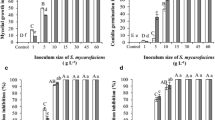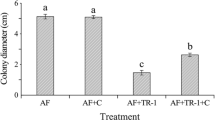Abstract
The antifungal activity of acetophenone and phenylethyl alcohol prevents seed contamination by Aspergillus flavus TISTR 3041 and A. parasiticus TISTR 3276. Their effects on seed germination were investigated. In vitro results showed that 100 µL L−1 acetophenone completely inhibited (by 100%) growth, conidial germination, and sporulation of the two aflatoxin-producing fungi, while phenylethyl alcohol showed only weak inhibitory activity even at 1000 µL L−1. Exposure to acetophenone at 100 µL L−1 for 6 h could completely kill (100% death) both fungal strains, while phenylethyl alcohol showed much lower efficacy (53.12%). In vivo results revealed that fumigation with 100 µL L−1 acetophenone for 24 h completely controlled (100%) A. flavus TISTR 3041 on soybean seeds during a 14-day test but exhibited weak efficacy on A. parasiticus TISTR 3276 (31.77%). Phenylethyl alcohol (1000 µL L−1) demonstrated weak inhibitory effect against both strains. The two volatile compounds had no adverse effects on seed germination. SEM confirmed that acetophenone could completely inhibit conidia germination, and abnormal growth of both fungal strains was observed. Thus, acetophenone has high potential to protect soybean seeds against aflatoxin-producing fungi.






Similar content being viewed by others
References
Ando H, Hatanaka K, Ohata I, Yamashita-Kitaguchi Y, Kurata A, Kishimoto N (2012) Antifungal activities of volatile substances generated by yeast isolated from Iranian commercial cheese. Food Control 26:472–478
Boukaew S, Prasertsan P (2014) Suppression of rice sheath blight disease using heat stable culture filtrate of Streptomyces philanthi RM-1-138. Crop Prot 61:1–10
Boukaew S, Chuenchit S, Petcharat V (2011) Evaluation of Streptomyces spp. for biological control of Sclerotium root and stem rot and Ralstonia wilt of chili. Biocontrol 56:347–365
Boukaew S, Plubrukam A, Prasertsan P (2013) Effect of volatile substances from Streptomyces philanthi RM-1-138 on growth of Rhizoctonia solani on rice leaf. Biocontrol 58:471–482
Boukaew S, Petlamul W, Bunkrongcheap R, Chookaew T, Kabbua T, Thippated A, Prasertsan P (2018) Fumigant activity of volatile compounds of Streptomyces philanthi RM-1-138 and pure chemicals (acetophenone and phenylethyl alcohol) against anthracnose pathogen in postharvest chili fruit. Crop Prot 103:1–8
Chavan VA, Padule DN (2005) Effect of seed dressers on seed germination, seedling vigour index and control of purple stain disease of soybean. In: Khetarpal R, Gupta K, Chalam VC, Gour HN, Thakore BBL, Bhargava S (eds) Proceedings of second global conference on plant healthgava,n: wealth, 25 proceedings of second global conferencMaharana Pratap University of Agriculture and Technology, India, pp 359–360
Corcuff R, Mercier J, Tweddell R, Arul J (2011) Effect of water activity on the production of volatile organic compounds by Muscodor albus and their effect on three pathogens in stored potato. Fungal Biol 115:220–227
Doolotkeldieva TD (2010) Microbiological control of flour-manufacture: dissemination of mycotoxins producing fungi in cereal products. Microbiol Insights 3:1–15
Francesco AD, Ugolini L, Lazzeri L, Mari M (2015) Production of volatile organic compounds by Aureobasidium pullulans as a potential mechanism of action against postharvest fruit pathogens. Biol Control 81:8–14
Gul M, Gul HI, Vepsalainen J, Erciyase E, Hanninen O (2001) Effect of acetophenone derived Mannich bases on cellular glutathione level in Jurkat cells. Arzneimittelforschung 51:679–682
Gul HI, Ojanen T, Hanninen O (2002) Antifungal evaluation of bis mannich bases derived from acetophenones and their corresponding piperidinols and stability studies. Biol Pharm Bull 25:1307–1310
Hua H, Xing F, Selvaraj JN, Wang Y, Zhao Y, Zhou L, Liu X, Liu Y (2014) Inhibitory effect of essential oils on Aspergillus ochraceus growth and ochratoxin A production. PLoS ONE 9(9):e108285
Huang R, Li GQ, Zhang J, Yang L, Che HJ, Jiang DH, Huang HC (2011) Control of postharvest botrytis fruit rot of strawberry by volatile organic compounds of Candida intermedia. Dis Control Pest Manag 101:859–869
Kavitha A, Prabhakar P, Narasimhulu M, Vijayalakshmi M, Venkateswarlu Y, Rao KV, Raju VBS (2010) Isolation, characterization and biological evaluation of bioactive metabolites from Nocardia levis MK-VL_113. Microbiol Res 165:199–210
Kordali S, Cakir A, Akcin TA, Mete E, Akcin A, Aydin T, Kilic H (2009) Antifungal and herbicidal properties of essential oils and n-hexane extracts of Achillea gypsicola Hub-Mor and Achillea biebersteinii Afan. Ind Crops Prod 29:562–570
Li Q, Ning P, Zheng L, Huang J, Li G, Hsiang T (2010) Fumigant activity of volatiles of Streptomyces globisporus JK-1 against Penicillium italicum on Citrus microcarpa. Postharvest Biol Technol 58:157–165
Li Q, Ning P, Zheng L, Huang J, Li G, Hsiang T (2012) Effects of volatile substances of Streptomyces globisporus JK-1 on control of Botrytis cinerea on tomato fruit. Biol Control 61:113–120
Li WR, Shi QS, Ouyang YS, Chen YB, Duan SS (2013) Antifungal effects of citronella oil against Aspergillus niger ATCC 16404. Appl Microbiol Biotechnol 97:7483–7492
Liarzi O, Bar E, Lewinsohn E, Ezra D (2016) Use of the endophytic fungus Daldinia cf.concentrica and its volatiles as bio-control agents. PLoS ONE 11(12):e0168242
Nasir N (2003) Effect of fungicides in limiting the growth of seed borne fungi of soybean. Pak J Plant Pathol 2:119–122
Naznin HA, Kiyohara D, Kimura M, Miyazawa M, Shimizu M, Hyakumachi M (2014) Systemic resistance induced by volatile organic compounds emitted by plant growth promoting fungi in Arabidopsis thaliana. PLoS ONE 9(1):e86882
Ng’ang’a J, Mutungi C, Imathiu S, Affognon H (2016) Effect of triple-layer hermetic bagging on mould infection and aflatoxin contamination of maize during multi-month on-farm storage in Kenya. J Stored Prod Res 69:119–128
Petrovic J, Glamoclija J, Stojkovic DS, Ciric A, Nikolic M, Bukvicki D, Guerzoni ME, Sokovic MD (2013) Laetiporus sulphureus, edible mushroom from Serbia: investigation on volatile compounds, in vitro antimicrobial activity and in situ control of A. flavus in tomato paste. Food Chem Toxicol 59:297–302
Prakash B, Singh P, Goni R, Raina AKP, Dubey NK (2015) Efficacy of Angelica archangelica essential oil, phenyl ethyl alcohol and α-terpineol against isolated molds from walnut and their antiaflatoxigenic and antioxidant activity. J Food Sci Technol 52:2220–2228
Qiming X, Haidong C, Huixian Z, Daqiang Y (2006) Allelopathic activity of volatile substance from submerged macrophytes on Microcystin aeruginosa. Acta Ecol Sin 26:3549–3554
Rabea EI, Badawy MET, Stevens CV, Smagghe G, Steubaurt W (2003) Chitosan as antimicrobial agent: applications and mode of action. Biomacromol 4:1457–1465
Rahman A, Shanta ZS, Rashid MA, Parvin T, Afrin S, Khatun MK, Sattar MA (2016) In vitro antibacterial properties of essential oil and organic extracts of Premna integrifolia Linn. Arab J Chem 9:S475–S479
Raza W, Yuan J, Ling N, Huang Q, Shen Q (2015) Production of volatile organic compounds by an antagonistic strain Paenibacillus polymyxa WR-2 in the presence of root exudates and organic fertilizer and their antifungal activity against Fusarium oxysporum f. sp. niveum. Biol Control 80:89–95
Sang MK, Kim KD (2012) The volatile-producing Flavobacterium johnsoniae strain GSE09 shows biocontrol activity against Phytophthora capsici in pepper. J Appl Microbiol 113:383–398
Sangmanee P, Hongpattarakere T (2014) Inhibitory of multiple antifungal components produced by Lactobacillus plantarum K35 on growth, aflatoxin production and ultrastructure alterations of Aspergillus flavus and Aspergillus parasiticus. Food Control 40:224–233
Sumalan RM, Alexa E, Poiana AM (2013) Assessment of inhibitory potential of essential oils on natural mycoflora and Fusarium mycotoxins production in wheat. Chem Cent J 7:1–12
Svircev AM, Smith RJ, Zhouc T, Hernadez M, Liu W, Chud CL (2007) Effects of thymol fumigation on survival and ultrastracture of Monilinia fructicola. Postharvest Biol Technol 45:228–233
Wan M, Li G, Zhang J, Jiang D, Huang HC (2008) Effect of volatile substances of Streptomyces platensis F-1 on control of plant fungal diseases. Biol Control 46:552–559
Wang C, Wang Z, Qiao X, Li Z, Li F, Chen M, Wang Y, Huang Y, Cui H (2013) Antifungal activity of volatile organic compounds from Streptomyces alboflavus TD-1. FEMS Microbiol Lett 341:45–51
You C, Zhang C, Feng C, Wang J, Kong F (2015) Myroides odoratimimus, a biocontrol agent from the rhizosphere of tobacco with potential to control Alternaria alternata. Biocontrol 60:555–564
Young GP, Bush JK (2009) Assessment of the allelopathic potential of Juniperus ashei on germination and growth of Bouteloua curtipendula. J Chem Ecol 35:74–80
Yuelian L, Qingfang L (2013) Inhibitory effects of Acremonium sp. on Fusarium wilt in bananas. Afr J Agric Res 8:6241–6249
Zheng M, Shi J, Shi J, Wang Q, Yanhua L (2013) Antimicrobial effects of volatiles produced by two antagonistic Bacillus strains on the anthracnose pathogen in postharvest mangos. Biol Control 65:200–206
Acknowledgements
This research work was financially supported by the Agricultural Research Development Agency (Public Organization) (PRP5905021490) and Thailand Research Fund (RTA6080010).
Author information
Authors and Affiliations
Corresponding author
Electronic supplementary material
Below is the link to the electronic supplementary material.
Rights and permissions
About this article
Cite this article
Boukaew, S., Prasertsan, P. Inhibitory effects of acetophenone or phenylethyl alcohol as fumigant to protect soybean seeds against two aflatoxin-producing fungi. J Food Sci Technol 55, 5123–5132 (2018). https://doi.org/10.1007/s13197-018-3458-6
Revised:
Accepted:
Published:
Issue Date:
DOI: https://doi.org/10.1007/s13197-018-3458-6




